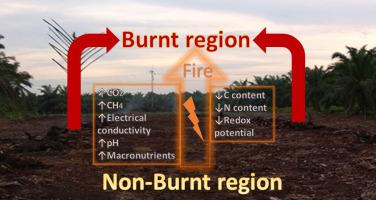Science of the Total Environment ( IF 8.2 ) Pub Date : 2020-06-30 , DOI: 10.1016/j.scitotenv.2020.140648 Selvakumar Dhandapani 1 , Stephanie Evers 2

|
Fire is one of the major issues facing Southeast Asian peatlands causing socio-economic, human health and climate crises. Many of these fires in the region are associated with land clearing or management practices for oil palm plantations. Here we study the direct post-fire impacts of slash-and-burn oil palm agriculture on greenhouse gas emissions, peat physico-chemical properties and nutrient concentrations. Greenhouse gas (GHG) emissions were measured using Los Gatos ultraportable greenhouse gas analyser one month after a fire in dry season and five months after the fire event, in wet season. Surface soil samples were collected from each individual GHG measurement points, along with 50 cm cores from both burnt and non-burnt control areas for lab analyses. As an immediate post-fire impact, carbon dioxide (CO2) and methane (CH4) emissions, pH, electrical conductivity, and all macronutrient concentrations except nitrogen (N) were increased multi-fold, while the redox potential, carbon (C) and N content were greatly reduced in the burnt region. While some of the properties such as CO2 emissions, and electrical conductivity reverted to normal after five months, other properties such as CH4 emissions, pH and nutrient concentrations remained high in the burnt region. This study also found very high loss of surface peat C content in the burnt region post fire, which is irreversible. The results also show that surface peat layers up to 20 cm depth were affected the most by slash-and-burn activity in oil palm agriculture, however the intensity of fire can vary widely between different oil palm management and needs further research to fully understand the long term and regional impacts of such slash-and-burn activity in tropical peatlands.
中文翻译:

油棕的“刀耕火种”做法增加了农业热带泥炭地烧毁后的温室气体排放量和养分浓度。
火灾是东南亚泥炭地面临的主要问题之一,引起社会经济,人类健康和气候危机。该地区的许多火灾与油棕种植园的土地清理或管理做法有关。在这里,我们研究了刀耕火种的油棕农业对篝火的直接影响,包括温室气体排放,泥炭的理化特性和养分浓度。在干燥季节发生火灾后一个月,在潮湿事件发生火灾后五个月,使用Los Gatos超便携式温室气体分析仪测量温室气体(GHG)排放。从每个单独的GHG测量点收集地表土壤样品,并从燃烧和非燃烧对照区域收集50厘米岩心,以进行实验室分析。火灾后,二氧化碳(CO 2)和甲烷(CH 4)排放,pH,电导率以及除氮(N)以外的所有常量营养素浓度成倍增加,而燃烧区的氧化还原电势,碳(C)和氮含量大大降低。尽管一些特性(例如,CO 2排放和电导率)在五个月后恢复正常,但其他特性(例如,CH 4)燃烧区的废气,pH和养分浓度仍然很高。这项研究还发现,燃烧后燃烧区域的表层泥炭C损失非常高,这是不可逆的。结果还表明,在油棕农业中,高达20 cm深度的表层泥炭层受到刀耕火种的影响最大,但是在不同的油棕管理方式下,火势变化很大,需要进一步研究以充分理解在热带泥炭地进行这种刀耕火种的长期和区域影响。











































 京公网安备 11010802027423号
京公网安备 11010802027423号